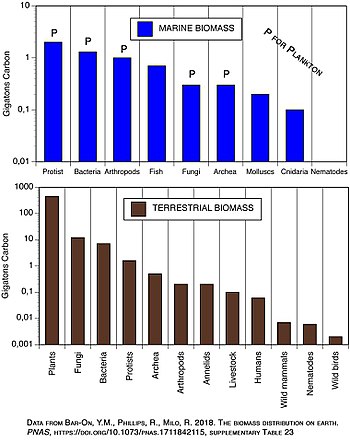Biomasa (ekologia)
Biomasa – łączna masa organizmów w danym ekosystemie[1].
Szacowana biomasa wszystkich organizmów i wirusów w biosferze Ziemi wynosi 550 Gt węgla, przy czym[2]:

Całkowita biomasa lądowa i morska według formy życia[2]
- rośliny – 450 Gt C
- bakterie – 70 Gt C
- grzyby – 12 Gt C
- archeony – 7 Gt C
- protisty – 4 Gt C
- zwierzęta – 2 Gt C:
- stawonogi – 1,2 Gt C:
- morskie – 1 Gt C
- lądowe – 0,2 Gt C
- ryby – 0,7 Gt C
- pierścienice – 0,2 Gt C
- mięczaki – 0,2 Gt C
- parzydełkowce – 0,1 Gt C
- zwierzęta gospodarskie – 0,1 Gt C
- ludzie – 0,06 Gt C
- nicienie – 0,02 Gt C
- dzikie ssaki – 0,007 GtC
- dzikie ptaki – 0,002 GtC
- stawonogi – 1,2 Gt C:
- wirusy – 0,2 Gt C
Zobacz też
Przypisy
- ↑ Biomass. Encyclopedia.com. [dostęp 2018-06-21]. (ang.).
- ↑ a b Yinon M. Bar-On, Rob Phillips, Ron Milo: The biomass distribution on Earth. [w:] Proceedings of the National Academy of Sciences of the United States of America [on-line]. National Academy of Sciences. [dostęp 2018-06-21]. (ang.).
Media użyte na tej stronie
Biomass by life form.jpg
Autor: John Richard Dolan, Licencja: Attribution
A graph showing total terrestrial and marine biomass, by life form.
Autor: John Richard Dolan, Licencja: Attribution
A graph showing total terrestrial and marine biomass, by life form.
